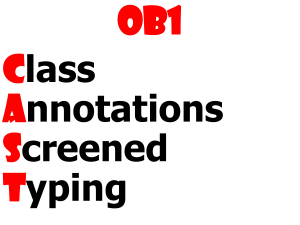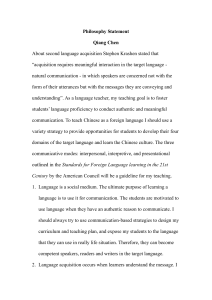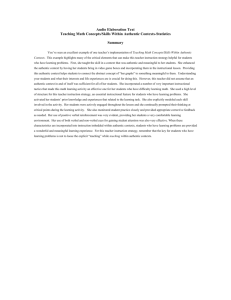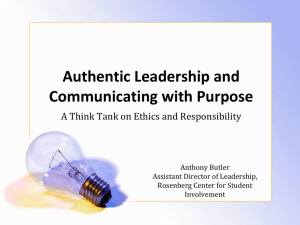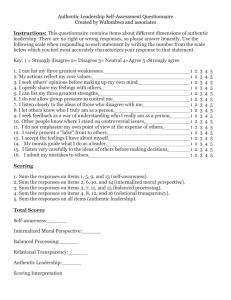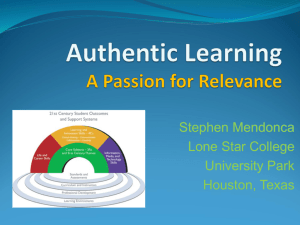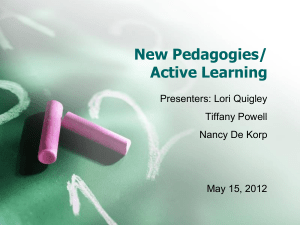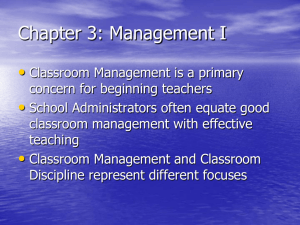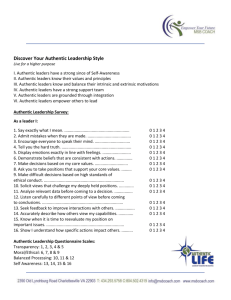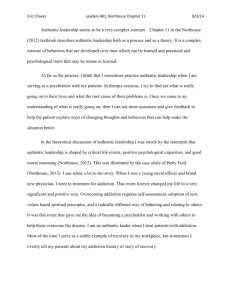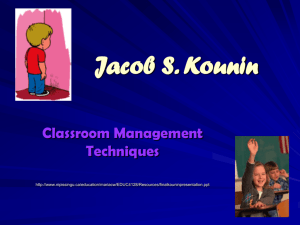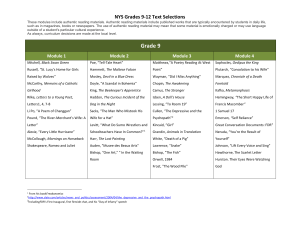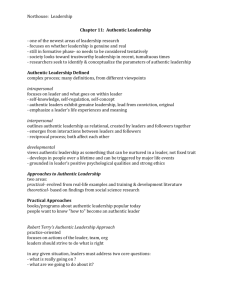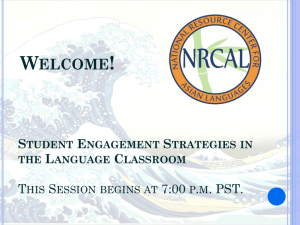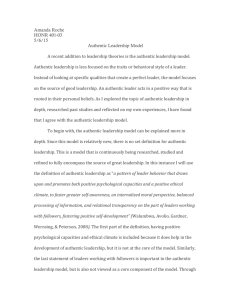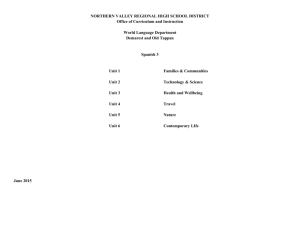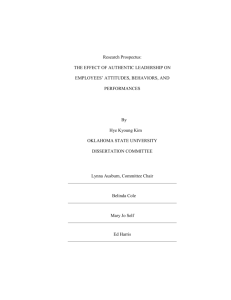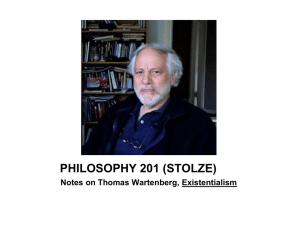TIME - Kirkwood Community College
advertisement
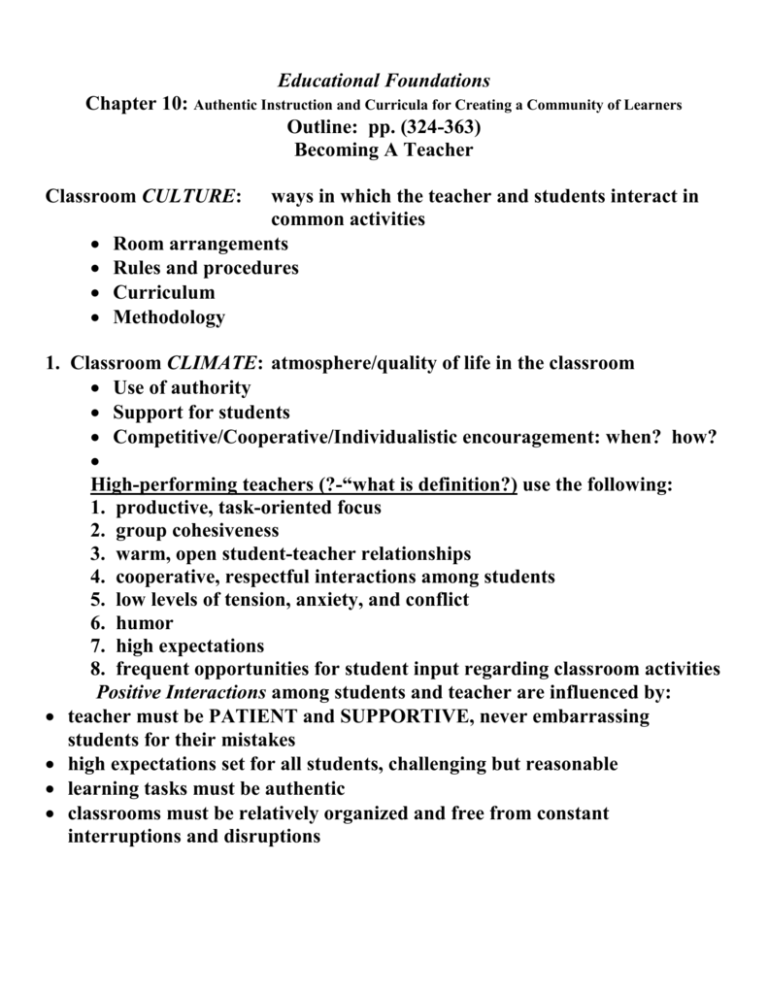
Educational Foundations Chapter 10: Authentic Instruction and Curricula for Creating a Community of Learners Outline: pp. (324-363) Becoming A Teacher Classroom CULTURE: ways in which the teacher and students interact in common activities Room arrangements Rules and procedures Curriculum Methodology 1. Classroom CLIMATE: atmosphere/quality of life in the classroom Use of authority Support for students Competitive/Cooperative/Individualistic encouragement: when? how? High-performing teachers (?-“what is definition?) use the following: 1. productive, task-oriented focus 2. group cohesiveness 3. warm, open student-teacher relationships 4. cooperative, respectful interactions among students 5. low levels of tension, anxiety, and conflict 6. humor 7. high expectations 8. frequent opportunities for student input regarding classroom activities Positive Interactions among students and teacher are influenced by: teacher must be PATIENT and SUPPORTIVE, never embarrassing students for their mistakes high expectations set for all students, challenging but reasonable learning tasks must be authentic classrooms must be relatively organized and free from constant interruptions and disruptions 2. CLASSROOM ORGANIZATION A. Grouping: 1. BETWEEN-CLASS: “tracking,” students assigned to classes on basis of ability and/or achievement (testing) 2. WITHIN-CLASS: instruction in small, homogeneous groups (math, reading) 3. Regrouping 4. COOPERATIVE LEARNING: (1954: Brown v. Board of Education) Groups of 2-6 work together on activities Students must assist and collaborate Groups may compete against one another (no within-group competition) Group members contribute to group goals according to own talents, interests, and abilities B. Instruction: an activity is authentic when learner feels emotionally involved and mentally stimulated, has choices and makes decisions, feels (self) has something to bring to the activity and that the outcome is important. (Thelen, 1981) AUTHENTIC LEARNING TASKS enable students to see the connections between classroom learning and the world beyond the classroom-both now and in the future. 1. 2. 3. 4. 5. TIME allocated time: amount of time for instruction in various content/subject time-on-task: amount of time students are actively engaged in learning activities academic learning time: amount of time a student spends working on academic tasks with a high level of success opportunity to learn OTL:teachers should use time to provide all students with challenging content through appropriate instruction block scheduling: ( Ask: How many of you are familiar? Examples) C. Management: how teachers structure classrooms to prevent/minimize problems PROACTIVE Qualities of the teacher: 1. “With-it-ness” (Kounin) eyes-in-the-back-of-your-head 2. “Ripple effect” (Kounin) use individual examples to reinforce behaviors 3. Multi-tasking 4. Smooth transitions Effective teachers establish and consistently maintain RULES and PROCEDURES: Clear, concise, reasonable, few in number Effective teachers organize and plan for instruction: Meaningful, engaging tasks, grouping, feedback and assessment Discipline: methods used after student has misbehaved, etc. (Beliefs About Discipline Inventory: handout from website: www.ablongman.com/parkay6e) Question: 1) Management styles you have encountered? Liked? Disliked? WHY? 3. METHODS OF INSTRUCTION a. DIRECT INSTRUCTION: focuses on the transmission of knowledge and skills from the teacher/curriculum to the student (Learning New Behaviors) BEST USE: step-by-step knowledge acquisition and basic skills development b. Mastery Learning (Madeline Hunter) all students can learn material if given enough time and appropriate teaching methods students learn best when they participate in a structured, systematic program of learning that enables them to progress in small, sequenced steps: 1. 2. 3. 4. 5. 6. Pretest Set objectives Direct Instruction with modeling Guided practice and feedback Posttest/Assessment Reteach c. Constructivist Teaching: (Child Development) 1. elicit students’ prior knowledge of material-start from this point 2. teacher reflects on students’ own learning process, provides scaffolding (only enough support to enable students to discover material on his/her own. Vygotsky: zone of proximal development = point at which students need assistance in order to continue learning 3. students put new information into memory (short-term, long-term) and use that information to construct meaning 4. community of learners established to share information, insights, and solve problems d. Information Processing: (Thinking Process) 1. Gathering/representing information = encoding 2. Holding information = storage 3. Getting information when needed = retrieval e. Inquiry/Discovery Learning: students are given opportunities to inquire into subjects so they “discover” knowledge for themselves f. Peer-mediated Instruction: 1. Cooperative Learning 2. Group Investigation (GI) 3. Peer-tutoring 4. Cross-age tutoring 4. EFFECTIVE TEACHING a. OUTCOMES: Students acquire an understanding of the subject studies Apply knowledge to new situations Desire to continue learning b. CHARACTERISTICS of effective teaching: 1. Planning and Preparation: Broad GOALS, Measurable OBJECTIVES To ASSESS use FORMATIVE and SUMMATIVE EVALUATIONS Measurement involves gathering data Evaluation is making a judgment/giving value AUTHENTIC ASSESSMENTS = students create, perform, problem-solve PERFORMANCE ASSESSMENT PORTFOLIO ASSESSMENT = collection/compilation of students’ work 2. Classroom Environment 3. Instruction 4. Professional Responsibilities 5. KINDS OF CURRICULUM EXPLICIT CURRICULUM = what a school intends to teach students HIDDEN CURRICULUM = behaviors, attitudes, and knowledge the culture of the school unintentionally teaches students NULL CURRICULUM = what is not taught in schools EXTRA/COCURRICULAR PROGRAMS : a) larger the school, less likely that a student will participate, b) those who do participate tend to have higher self-concepts that those who do not, c) students who participate tend to receive higher grades, d) at-risk students tend not to participate, e) students from low SES participate less 6. CURRICULUM DEVELOPMENT TYLER RATIONALE: ask the following What educational purposes should the school seek to attain? What educational experiences can be provided that are likely to attain these purposes? How can these educational experiences be effectively organized? How can we determine whether these purposes are being attained? SUBJECT-CENTERED CURRICULUM emphasizes logical order of study in the discipline STUDENT-CENTERED CURRICULUM teaches content, but emphasis is on growth and development of the student What influences curricular decisions? Brainstorm societal influences

